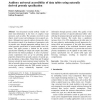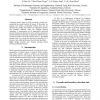ICASSP
2011
IEEE
13 years 7 months ago
2011
IEEE
One problem in concatenative speech synthesis is how to incorporate prosodic factors in the unit selection. Imposing a predicted prosodic target is error-prone and does not benefi...
ICASSP
2011
IEEE
13 years 7 months ago
2011
IEEE
We describe recent progress in the field of prosodic modeling for speaker verification. In a previous paper, we proposed a technique for modeling syllable-based prosodic feature...
UAIS
2010
13 years 10 months ago
2010
Abstract Text documents usually embody visually oriented meta-information in the form of complex visual structures, such as tables. The semantics involved in such objects result in...
INTERSPEECH
2010
13 years 10 months ago
2010
Continuous speech input for ASR processing is usually presegmented into speech stretches by pauses. In this paper, we propose that smaller, prosodically defined units can be ident...
CORR
2000
Springer
14 years 3 months ago
2000
Springer
A crucial step in processing speech audio data for information extraction, topic detection, or browsing/playback is to segment the input into sentence and topic units. Speech segm...
SPEECH
2008
14 years 3 months ago
2008
In this paper, we propose a new approach for extracting and representing prosodic features directly from the speech signal. We hypothesize that prosody is linked to linguistic uni...
CSL
2008
Springer
14 years 3 months ago
2008
Springer
This paper describes the design and evaluation of prosodically-sensitive concatenative units for a Korean text-to-speech (TTS) synthesis system. The diphones used are prosodically...
COLING
2000
14 years 5 months ago
2000
In this paper, we investigate the acoustic prosodic marking of demonstrative and personal pronouns in taskoriented dialog. Although it has been hypothesized that acoustic marking ...
NAACL
2004
14 years 5 months ago
2004
This paper investigates the usefulness of sentence-internal prosodic cues in syntactic parsing of transcribed speech. Intuitively, prosodic cues would seem to provide much the sam...
TSD
2004
Springer
14 years 9 months ago
2004
Springer
Abstract. A formal prosody model is proposed together with its application in a text-to-speech system. The model is based on a generative of abstract prosodic functionally involved...






